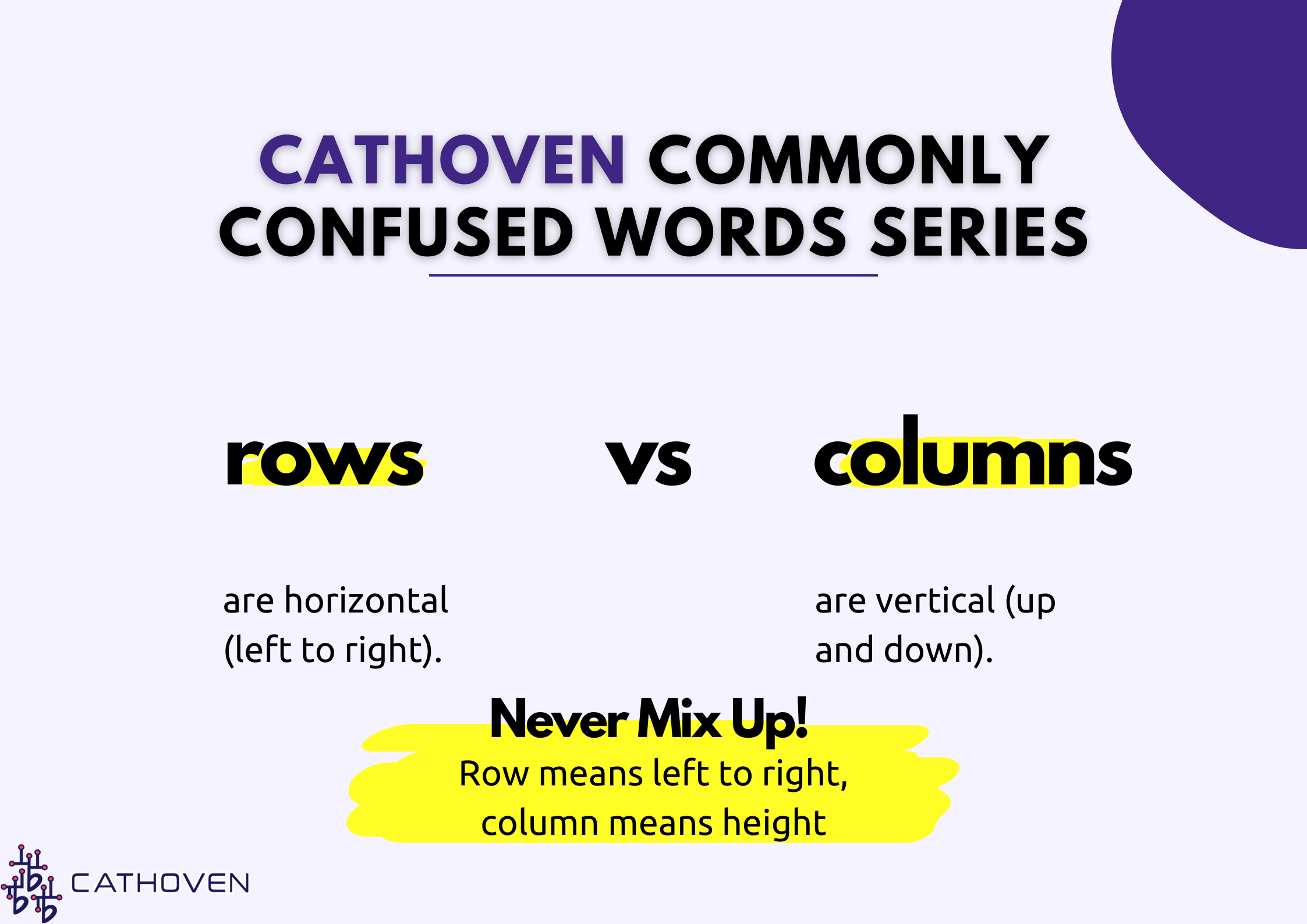Rows and columns are essential concepts in both everyday language and more specialized contexts, such as in spreadsheets or architecture. However, learners often confuse these terms. Understanding the difference can enhance clarity in communication and ensure better comprehension in reading and writing tasks.
In this post, we’ll break down the differences between rows and columns, provide real-world examples, and offer insights into how they are used at different CEFR levels.
What is a Row?
A row is a horizontal arrangement of people, objects, or information placed side by side. It’s often encountered in daily life—whether it’s seating arrangements, books on a shelf, or data in a spreadsheet.
- CEFR Level: A2
Rows are typically introduced at the A2 (Elementary) level, especially in contexts like describing spatial arrangements.
Examples of Rows in Sentences:
- The students sat in a neat row during the ceremony. (A2)
- Books were aligned in a row on the shelf. (B1)
- The houses in the neighborhood are built in long rows. (B2)
What is a Column?
A column, on the other hand, is a vertical arrangement where objects, text, or information is stacked one on top of the other. The term can refer to structures in buildings or elements in spreadsheets.
- CEFR Level: B1
Learners are introduced to the term “column” around B1 (Intermediate) level, particularly in contexts like data organization and architecture.
Examples of Columns in Sentences:
- The plates were stacked into a tall column. (B1)
- The spreadsheet organizes the data in columns. (B2)
- Ancient Greek buildings often feature large, supporting columns. (C1)
Examples for Using “Rows”
A2 Level (Elementary)
- The students sat in a row for the class photo.
- Simple sentence showing spatial arrangement.
- There is a row of apples on the kitchen counter.
- Common objects placed side by side.
B1 Level (Intermediate):
- The chairs in the theater were arranged in rows, facing the stage.
- Describing rows in a more specific context like seating arrangements.
- Rows of vegetables were planted in the garden, separated by small paths.
- Describing a clear, organized arrangement in nature.
B2 Level (Upper-Intermediate):
- The houses in this neighborhood are built in long rows along the street. facing the stage.
- More complex sentence involving urban or architectural planning.
- In the Excel sheet, I added the sales data in the first row.
- Introducing rows in the context of spreadsheet use.
C1 Level (Advanced):
- The students’ names were written in rows on the class roster to make it easier to read.
- Sentence involving a more formal setting, such as documentation.
- The long rows of solar panels captured sunlight, contributing to the town’s renewable energy supply.
- More abstract usage, involving technology and science.
Examples for Using “Columns”
A2 Level (Elementary)
- The blocks were stacked into a tall column.
- Basic sentence showing a simple vertical arrangement.
- The newspaper had an article in the first column.
- Common use in media or reading.
B1 Level (Intermediate):
- In the Excel sheet, the data is organized in columns and rows.
- Introducing spreadsheet terminology.
- The ancient temple had large stone columns supporting the roof.
- Describing columns in the context of architecture.
B2 Level (Upper-Intermediate):
- The periodic table is arranged in columns that group elements with similar properties.
- Introducing the concept in a scientific context.
- In the report, the survey results were organized into three columns for better readability.
- Business or academic context, emphasizing data organization.
C1 Level (Advanced):
- The towering columns of smoke rose into the sky after the volcano erupted
- More abstract and figurative use of the word in advanced contexts.
- The spreadsheet’s error came from placing the data in the wrong columns, which affected the overall analysis.
- Complex usage involving mistakes in data manipulation
Key Differences Between Rows and Columns
The most straightforward way to distinguish between rows and columns is in their orientation:
- Rows are horizontal (left to right).
- Columns are vertical (up and down).
A simple way to remember this is the rhyme: “Row means left to right, column means height”
Practical Applications
Cathoven’s AI-powered tools can assist teachers and learners in practicing important concepts through real-life scenarios. For example, the Exercise Creator allows you to generate comprehension exercises by simply providing a text. To make it easier, we’ve created an example text for you—just click ‘use example text‘ to get started. Once the text is in place, you can create multiple-choice questions, true/false, and short-answer questions in seconds!

Click the “use an example text” below and start creating questions to measure your students’ understanding of rows and columns!
Try with your own text right now (simple version)
Multiple choice
Number of remaining chances: 3
The result will be shown here:
*No credit card or upfront payment required to use
Frequently asked questions about rows and columns
Rows refer to items that are arranged horizontally, side by side, such as products lined up on a grocery store shelf or desks positioned in a classroom.
Columns describe things that are placed vertically, like a pile of coins, or aligned in a straight line, such as a column of smoke. The term can also apply to architectural structures like the pillars found in ancient Greek buildings.
In programs like Excel or Google Sheets, rows are the horizontal boxes running left to right (usually numbered), while columns are vertical boxes running top to bottom (typically labeled with letters).
